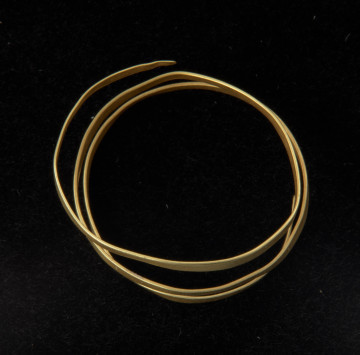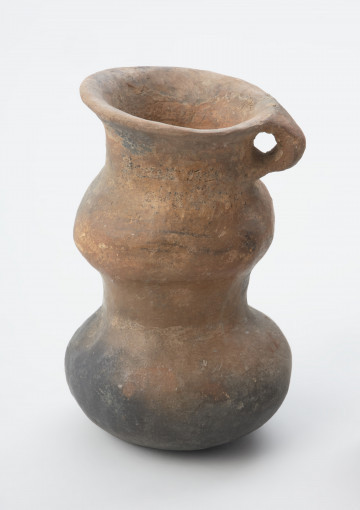
A Pfatten-type knife
around 1000 p.n.e. — 900 p.n.e.
National Museum in Szczecin
Part of the collection: Bronze Age
A delicate ornament composed of small bronze tubes separated by tiny blue glass beads was topped with a bronze pendant in the shape of a miniature double-bladed axe. It is a unique find. It comes from a grave discovered at the beginning of December 1935 during earthworks in Mr Bose's garden. Due to severe frosts, excavations under the direction of the Szczecin archaeologist Hans Jürgen Eggers did not start until spring 1936. The excavation revealed the remains of a 3 × 4 m rectangular stone pavement with burnt human bones and the so-called grave goods. The whole was covered by a layer of stones forming the mound's embankment. A total of 62 objects were found, including four earthenware vessels and various bronze objects (e.g., necklaces, bracelets, pins, a fibula, knives, tweezers, a razor, buttons, and bronze rings). They all enriched the collection of the Pommersches Landesmuseum in Stettin (Polish: Pomorskie Muzeum Krajowe w Szczecinie; English: Pomeranian State Museum in Szczecin), where they remained until they were evacuated deep into Germany in 1944. The grave furnishings were only returned to Szczecin in 2009 due to the Polish-German exchange of ancient archaeological artefacts. The barrow discovered in Banie, dated to the 2nd half of the 4th Bronze Age (approx. 1000-900 BC), is one of the most interesting archaeological findings from the younger Bronze Age in this part of Pomerania. Due to the richness of furnishings, it gained in scientific literature the name of the ducal tomb. The discovered objects are the work of local metalworkers, but they refer to the products from the south and north of Europe. The presented necklace should most probably be associated with Southern Europe.
Dorota Kozłowska
Author / creator
Dimensions
the entire object:
Object type
pendant, bead, collar necklace, body adornment
Technique
coating, rolling, casting
Material
glass, bronze, processed material
Origin / acquisition method
legal transfer
Creation time / dating
Creation / finding place
Owner
National Museum in Szczecin
Identification number
Location / status

around 1000 p.n.e. — 900 p.n.e.
National Museum in Szczecin

around 1700 p.n.e. — 1500 p.n.e.
National Museum in Szczecin

around 1100 p.n.e. — 750 p.n.e.
National Museum in Szczecin
DISCOVER this TOPIC
National Museum in Lublin
DISCOVER this PATH
Educational path